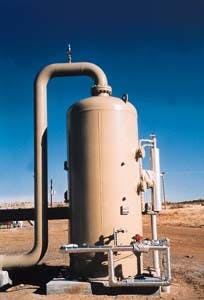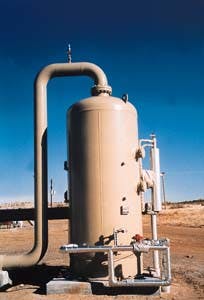Loren E. Gearhart
El Paso Field Services Co.
Farmington, N.M.
This 10-ft high contactor contains 2 trays but functions equivalent to 10 actual trays in a conventional column (Fig. 1).
- This is a view from the top of the contactor (Fig. 3 [16,534 bytes]).
- This view if from inside the contactor, looking over a tray that has had its usual layer of Pall rings removed (Fig. 4 [12,409 bytes]).
- The stripper (seen vertically behind the reboiler with vapor coming out its top) removes BTEX and VOCs and sends them to be burned as fuel in the reboiler (Fig. 5 [10,063 bytes]).
This is shown by the design and installation of a 10-equivalent-tray glycol-dehydration unit for field-gas dehydration, discussed here. The absorber design minimizes the absorption of VOCs and BTEX by requiring 1-1.5 gal of glycol/pound of water removed.
Glycol-unit VOC emissions are effectively controlled without installing vent-gas condensers which require disposal of the waste condensate. The emission-control system on this unit is simple to operate and meets emission standards, and the dehydrator design achieves pipeline-sales-gas specifications at a reasonable cost. The system reduces VOCs and BTEX by adding a stripper on the glycol going to the reboiler.
A 50-MMscfd dehydrator was installed in December 1995; results of an emission test in April 1997 are presented here. The unit is located 0.5 mile northeast of Bloomfield, N.M., on a natural-gas pipeline which operates from 170-300 psia and 35-80° F.
New standards
Starting later this year, the 1990 Clean Air Act Amendments will impose maximum achievable control technology (MACT) on oil and gas facilities with hazardous air pollutants (HAPS) greater than 25 tons/year in combination or 10 tons/year of any individual regulated HAP, such as BTEX.Equipment manufacturers and purchasers have become sensitive to this fact and have consequently developed new solutions.
Emissions from the glycol reboiler-still vent can be condensed or incinerated. The ideal solution would be to vent them directly to the atmosphere at levels which meet regulatory requirements.
Condensing the reboiler-still vent with ambient air and/or rich glycol coming from the absorber is currently being used to make significant reductions of BTEX emissions. Although capital cost is low and recovered hydrocarbons are salable, there is still a disposal problem with the contaminated aqueous phase.
Incineration of the reboiler-still vent at 1,800° F. eliminates liquid-disposal problems and allows the operator to meet air-quality standards. But the energy required to incinerate the overhead vapors, the initial capital investment, and the maintenance of this system make this a costly solution to the BTEX-emission problem.
It has been demonstrated that the amount of BTEX absorbed by glycol is proportional to the glycol circulation. Typical glycol-circulation rates for conventional contactors are 2-3 gal/lb of water removed.
Bloomfield plant
The contactor used at the Bloomfield facility requires only 1-1.5 gal of glycol for each 1 lb of water removed, thus cutting in half the amount of BTEX absorbed by conventional contactors. The patented fluid-packed column at this facility is different from the conventional packed column or trayed tower because it provides a better contact of the vapor and liquid phases.The contactor contains only 2 trays but is equivalent to 10 actual trays in a conventional column. The contactor shown in Fig. 1 [11,140 bytes] is 66 in. ID by 10 ft long, seam to seam.
In Fig. 2, [57,927 bytes] glycol enters a concentric ring which evenly distributes glycol to the top tray. Glycol flows out of the bottom center of the tray to an external bridle which contains an inner pipe that maintains a constant level of glycol on the top tray.
The glycol flows from the top of the bridle downward through the inner pipe and rises from the bottom of the bridle to a concentric ring on top of the second tray. The flow path is then repeated for the bottom tray.
Fig. 3 [16,534 bytes] is a top view of the contactor showing the concentric rings which feed glycol to the top of the tray.
Fig. 4 [12,409 bytes] is a view inside the contactor tray. (The tray is normally filled with 1-in. Pall rings, but the rings were removed when the photo was taken.) An additional emission-control device was installed between the three-phase separator and the 750,000-BTU/hr reboiler.
The patented BTEX stripper operates at 160-180° F. and 19 psig. BTEX and VOCs removed in the stripper are burned as fuel in the reboiler. The stripper can be seen in Fig. 5 [10,063 bytes] sitting vertically behind the reboiler. The vapor coming out of the top of the stripper is used as fuel to the reboiler.
Although this facility uses triethylene glycol (TEG), the manufacturer states that it is possible to use ethylene glycol and further reduce emissions by a factor of approximately 5.7 (based on the relative solubility of benzene) and still meet pipeline water specifications.1
The installed cost of the absorber/regenerator package was approximately $5,000/MMscfd of design capacity. A diagram of the system in shown in Fig. 6. [57,504 bytes]
Emission test
An emission test was run on this unit to obtain data for future air-permit applications. The testing was performed by Cubix Corp. on Apr. 30, 1997, in accordance with the U.S. Code of Federal Regulations, Title 40, Part 60, Appendix A, Methods 2a, 18, and EPA SW846, 3rd Edition, Method 8020A.All of the exhaust from the reboiler-still vent was passed through a condenser followed by a dry-gas meter. The volume of noncondensable vapor was measured and a sample was collected in a Tedlar bag for direct interface with a gas chromatograph.
The volume of aqueous and organic condensate was measured, and each phase of the condensate samples was analyzed for BTEX and VOCs. Total emission to the atmosphere is the sum of the emission rates calculated for the aqueous, organic, and noncondensable phases. A diagram of the sampling train is shown in Fig. 7. [63,780 bytes]
Samples of glycol were collected at the inlet and outlet of the contactor and downstream of the glycol stripper so that a comparison could be made of the atmospheric rich/lean (ARL) method with the total-capture-condensation (TCC) method. The operating conditions for each run are shown in Table 1. [44,463 bytes]
Table 2 [42,052 bytes] shows the emission rates in tons per year from the reboiler-still vent based on the TCC method. The VOC numbers include BTEX.
Table 3 [30,398 bytes] shows the emissions from the reboiler-still vent by measuring the BTEX in the glycol entering and leaving the glycol reboiler.
If one divides the average BTEX measured by the ARL method (Table 3) by the TCC method (Table 2), the result is approximately 0.85.
BTEX balance
The rich and lean glycol to and from the absorber as well as the inlet and outlet gas of the absorber were analyzed to estimate BTEX emissions. The gas and glycol analyses for the second run, LA4-5, are shown in Table 4. [66,993 bytes] The data in Table 4 were used to calculate the BTEX balance in Table 5. [38,492 bytes]That table shows that one cannot estimate reboiler-still-vent emissions by performing a BTEX balance based on a gas-phase analysis.
For example, the difference in the BTEX absorbed by the lean glycol entering the absorber and the rich glycol leaving the absorber for Run LA4-5 was 2.94 tons/year. The difference in the BTEX measured in the inlet and outlet of the absorber was 44.9 tons/year.
Current options for removal of BTEX and VOCs include condensation and incineration. This facility demonstrates a method of reducing emissions by reducing the absorption of BTEX and VOCs in the glycol contactor and by adding a stripper on the rich glycol going to the reboiler.
A comparison of the emissions from the vent stream from the reboiler shows that the ARL method was an average of 85% of the TCC method. A BTEX balance based on the ARL method compared with a BTEX balance based on a gas phase analysis shows that the latter should not be used to estimate emissions.
Reference
- "A Guide to Glycols," Dow Chemical Co., February 1992, p. 20.
The Author
Loren E. Gearhart is a principal engineer with El Paso Field Services and has more than 24 years' experience in gas processing. He holds a BS in chemical engineering from the University of Houston and an MS in chemical engineering from Oklahoma State University. He is a registered professional engineer in New Mexico and a member of AIChE.
Copyright 1998 Oil & Gas Journal. All Rights Reserved.




